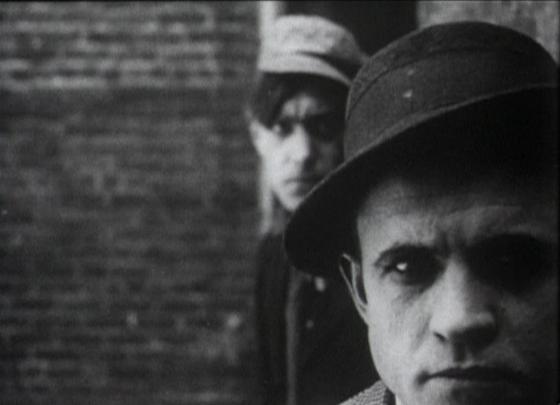
The Musketeers of Pig Alley is a 17-minute-long 1912 film directed by D. W. Griffith, starring 19-year-old Lillian Gish in one of the first films she ever had a role in.
Gish is "The Little Lady", who dwells with her musician husband and her frail mother in a shabby room in a dirty New York tenement. Her husband leaves town for a gig, leaving Gish vulnerable to the attentions of "Snapper Kid", leader of a gang of street thugs. She slaps him, which only seems to make Snapper Kid like her more. But a rival gangster also turns his eyes to the Little Lady, which leads to a confrontation with Snapper Kid.
The Musketeers of Pig Alley is one of the more well-remembered of the hundreds of short films Griffith directed early in his career. It is well known for an impressive shot in which the camera catches the Snapper Kid in the background coming around a corner, then remains focused on him as he creeps down the alleyway until his face looms huge in the camera. It has often been called the very first gangster movie, predating later works like The Public Enemy (1931) and Little Caesar by a generation. Martin Scorsese cited it as an influence on GoodFellas.
Lionel Barrymore has a small part as the musician's friend.
Tropes:
- The Big Rotten Apple: A title card describes Pig Alley as "New York's other side". There's a filthy garbage-strewn alley, there are prostitutes, there's a dive bar, there's a tenement where muggers lurk to steal your money. The film was actually shot on location in New York's decaying Five Points district, and the crowd shots provide a valuable time capsule of the period.
- Breaking the Fourth Wall: The Snapper Kid briefly looks into the camera during the famous close-up.
- Damn, It Feels Good to Be a Gangster!: What with the "links in the system" and well-wishers and bystanders who stand up for you.
- Dances and Balls: The whimsically named "Gangsters' Ball", which the Little Lady is more or less dragged to by a friend.
- The Dragon: The Snapper Kid has a sidekick who is always following along behind him and backing him up. He's played by Harry Carey, future cowboy star for early John Ford films.
- Dying Alone: The Little Lady's mother dies alone in their apartment, while the Little Lady is out selling the clothes she's made. There's even a title card that says "ALONE".
- Even Evil Has Standards: The Snapper Kid is a thief and murderer, but he won't stand for that other gangster trying to drug the Little Lady.
- Friendly Neighborhood Gangster: They aren't gangsters, they are musketeers and they have a moral code.
- The Irish Mob: At least, it certainly seems like the Irish mob—the one named character is called "Snapper Kid", and they definitely aren't Italians or Jews. The character of the Snapper Kid is strongly reminiscent of the Irish gangsters that James Cagney played in The '30s.
- Historically, the Irish Mob was on its last legs during the 1910s-early 30s, thanks to gentrification the number of young gangsters dried up and the next minority became the organized crime. See Ethnic Succession

- Historically, the Irish Mob was on its last legs during the 1910s-early 30s, thanks to gentrification the number of young gangsters dried up and the next minority became the organized crime. See Ethnic Succession
- Karma Houdini: All right, so the Snapper Kid saved the Little Lady from being drugged and raped, but he did club the musician over the head, and he is a criminal, and he did just engage in a violent shootout where he probably killed some people. He gets away clean. This is emphasized by the rather odd ending to the film. After the cop leaves without arresting the Snapper Kid, a final title card says "Links in the system." A hand enters from out of the camera frame and hands the Snapper Kid a wad of cash.
- Nameless Narrative: Very common in the early days of silent movies.
- Screw the Rules, I Have Connections!: Or rather, "links in the system." The final shot has someone, perhaps someone wealthy, handing Snapper Kid some cash.
- Slipping a Mickey: Another gangster, a rival to the Snapper Kid, manages to get the Little Lady to have a drink with him. While chatting with her, he shows her a picture, and while she is distracted, he slips something into her drink. The Snapper Kid sees this and slaps the drink out of Gish's hand. This triggers the fight between the Snapper Kid and the other gangster that leads to the climactic shootout. It's easy to miss the mickey-slipping if one isn't paying close attention to the rival gangster's hands. Also note that in the end, when the Snapper Kid is asking the Little Lady and the musician to give him an alibi, he mimes the put-something-in-a-drink motion. This is the "one good turn" that leads the Little Lady to lie to the cop.
